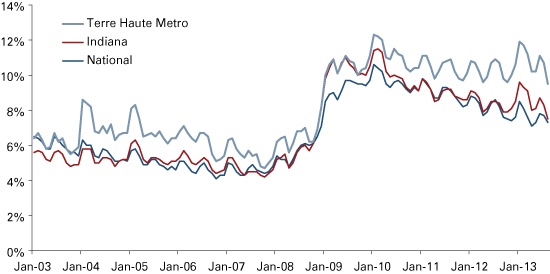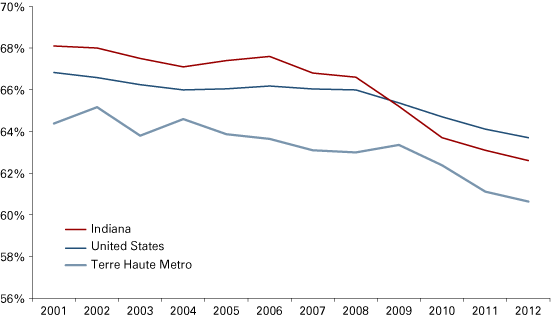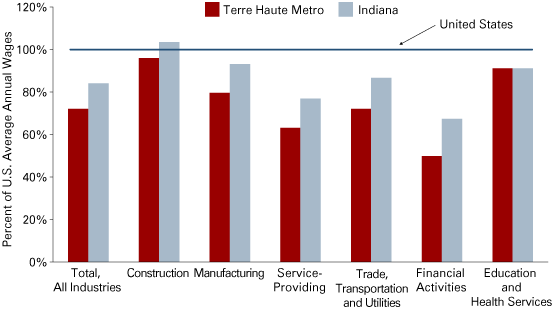Terre Haute Forecast 2014
Associate Professor of Economics, Rose-Hulman Institute of Technology
Professor of Economics, Indiana State University
The outlook for the Terre Haute regional economy continues to be clouded by persistent unemployment and an acceleration of a long-term downward trend in area employment. Our analysis suggests that the Terre Haute region faces not just a lagging cyclical downturn, but troubling long-term headwinds that will make it difficult for the region to remain an important economic hub. Long-term job loss, structural unemployment, unusual seasonality and below-average compensation all combine to paint a difficult picture of the local labor market and economy. The only current sources of optimism revolve around potential beneficial effects of the impending completion of the 641-bypass on the city’s southeast corner, and the 2015–2016 promised opening of a production facility by Nantworks, a California-based pharmaceutical company.
Labor Market Conditions
For most of the past decade, the Terre Haute region’s unemployment rate has lagged the state’s unemployment rate by 1 point to 2.5 points (see Figure 1). While the state unemployment rate was generally in line with the nation’s rate between 2004 and 2008, and again between the middle of 2010 and the middle of 2012, the Terre Haute region’s unemployment rate has remained stubbornly above both rates for most of this period. As the national unemployment rate began its slow descent from its peak in 2010, Indiana’s rate first tracked the national improvement, but surprisingly lagged behind the national rate for most of 2012. While the national and state recovery progressed slowly, the Terre Haute region’s labor market remained in the doldrums.
Figure 1: Unemployment Rates in Terre Haute, Indiana and the United States, January 2003 to August 2013

Note: Data are not seasonally adjusted.
Source: Bureau of Labor Statistics
The contrast between Terre Haute’s unemployment rate and the state’s unemployment rate is striking. Coming out of the 2001 recession, the Terre Haute rate was a point or two higher than statewide averages. The 2003 closure of Columbia House had a large, if temporary, effect of widening the gap to nearly 3 points. Between 2004 and through the worst of the Great Recession, the Terre Haute region largely caught up with the state. Since 2010, however, the city once again lags the state dramatically. We believe these data suggest that the Terre Haute region’s natural rate of unemployment may be 1 to 2 points higher than the state’s rate, perhaps because of a higher proportion of structural unemployment. The implications for the metro area are significant: even if the state unemployment rate drops to pre-Great Recession levels, an event neither of us believe likely, Terre Haute’s unemployment rate is likely to remain elevated.
An additional feature of the Terre Haute unemployment rate that deserves comment is that it has a seasonal element not present in state data. Table 1 shows how the September through December period is quite different in Terre Haute, with the gap between metro and state unemployment rates temporarily shrinking each year during that period. There are two explanations for this and both revolve around the holiday buying season. As home to the western hemisphere’s only Blu-ray facility, which also happens to be one of the world’s largest video game stamping locations, Terre Haute sees a tremendous boost in temporary, low-wage manufacturing employment during the fall months. Secondly, as a regional shopping center to west-central Indiana and east-central Illinois, the retail and restaurant businesses do quite well during that period.
Table 1: Unemployment Rate Deviations between the United States, Indiana and the Terre Haute Metro, 1990 to 2012
| 1990–2001 | 2002–2012 | |||
|---|---|---|---|---|
| U.S. from Indiana* | Indiana from Terre Haute** | U.S. from Indiana* | Indiana from Terre Haute** | |
| January | 1.4 | -1.5 | -0.1 | -1.3 |
| February | 1.1 | -1.5 | -0.3 | -1.3 |
| March | 1.1 | -1.5 | -0.4 | -1.1 |
| April | 1.1 | -1.5 | -0.2 | -1.1 |
| May | 1.1 | -1.5 | -0.1 | -1.2 |
| June | 1.4 | -1.5 | 0.0 | -1.3 |
| July | 1.7 | -1.0 | 0.1 | -1.1 |
| August | 1.4 | -1.4 | -0.1 | -1.3 |
| September | 1.6 | -1.1 | 0.1 | -1.0 |
| October | 1.4 | -1.2 | 0.0 | -0.8 |
| November | 1.3 | -1.2 | -0.1 | -0.9 |
| December | 1.2 | -1.4 | -0.2 | -1.0 |
*Positive numbers indicate a higher unemployment rate in the United States
**Positive numbers indicate a higher unemployment rate in Indiana
Note: Unemployment rates used for this table are not seasonally adjusted.
Source: Bureau of Labor Statistics
These observations about current labor market conditions occur against a backdrop of a long-term decline in area employment that seems to be picking up pace. Employment in the Terre Haute metro peaked at about 83,000 in late 1995. Over the ensuing 12 years, the metro lost about 6,000 jobs so that metro employment stood at about 77,000 on the eve of the Great Recession. Six years later, the Terre Haute metro is still struggling to emerge from the shadow of that recession and employment stands just above 70,000. As one would expect when jobs disappear from the local economy, labor force participation has declined as well. In part, this reflects a long-term national trend in declining labor force participation, but as Figure 2 shows, the pace of decline is slightly faster for the Terre Haute metro.
Figure 2: Labor Force Participation Rates in the Terre Haute Metro, Indiana and the United States, 2001 to 2012

Source: U.S. and Indiana, Bureau of Labor Statistics; Terre Haute Metro, authors’ estimates based on BLS and Census data
There is one final observation about the Terre Haute metro’s labor market that bears comment. As Figure 3 illustrates, the average annual pay in all private industries in the area is only about 70 percent of the national average. In manufacturing, average annual pay is less than 80 percent of the national average. Even accounting for lower costs of living in the area, these disparities seem significant. It seems that aside from the education and health services sectors, when the metro does attract or create jobs, those jobs tend to be below average in terms of annual pay. We believe that these data help explain why the region continues to experience significant brain drain.
Figure 3: Average Annual Pay in the Terre Haute Metro and Indiana as a Percent of U.S. Average Annual Pay for Selected Sectors, 2012

Source: Bureau of Labor Statistics, Quarterly Census of Employment and Wages
Outlook
This year’s outlook makes for difficult reading. While the nation and the rest of the state appear to be continuing an admittedly slow and painful recovery from the Great Recession, there are indications that the Terre Haute metro’s economy remains more sluggish and vulnerable to another economic downturn, if it were to occur. Outside of the education and health services sectors, where employment and compensation remain relatively strong, the region’s industrial composition offers little evidence of long-term economic health.
It is perhaps time for regional civic and business leaders to begin casting their nets a bit wider to attract new kinds of jobs to the area—jobs that will stem the tide of employment loss and that could contribute to a new sense of vibrancy and not just low-paying seasonal work. Nantworks has the potential to be such an employer, but its impact, assuming it comes to fruition, will not be a factor until after 2014. Nor will the 641-bypass have any noticeable economic impact until after 2014, and then it may only accelerate the addition of more retail operations, which tend to be lower-paying and partially seasonal. We understand that finding and attracting entirely new classes of employers is a tall order, but the reality of our reviews over the past few years is that the metro’s economy and labor market are not healthy, show little forward momentum, and more of the same will not change the outlook.




